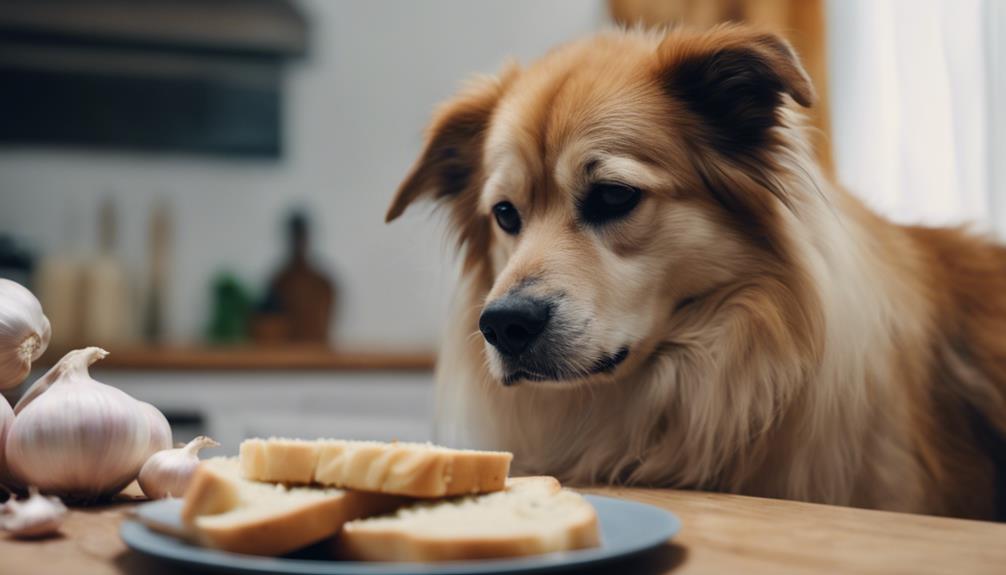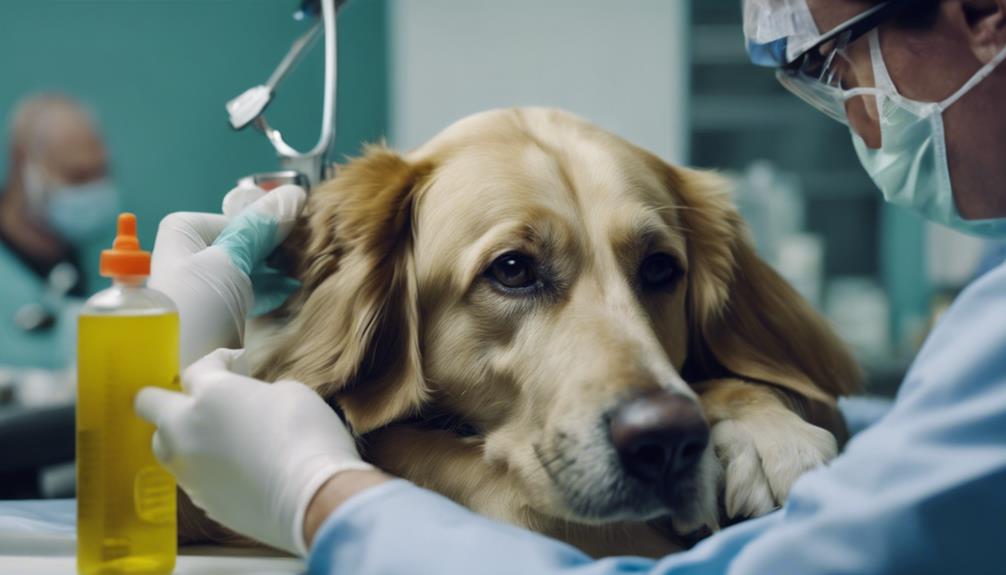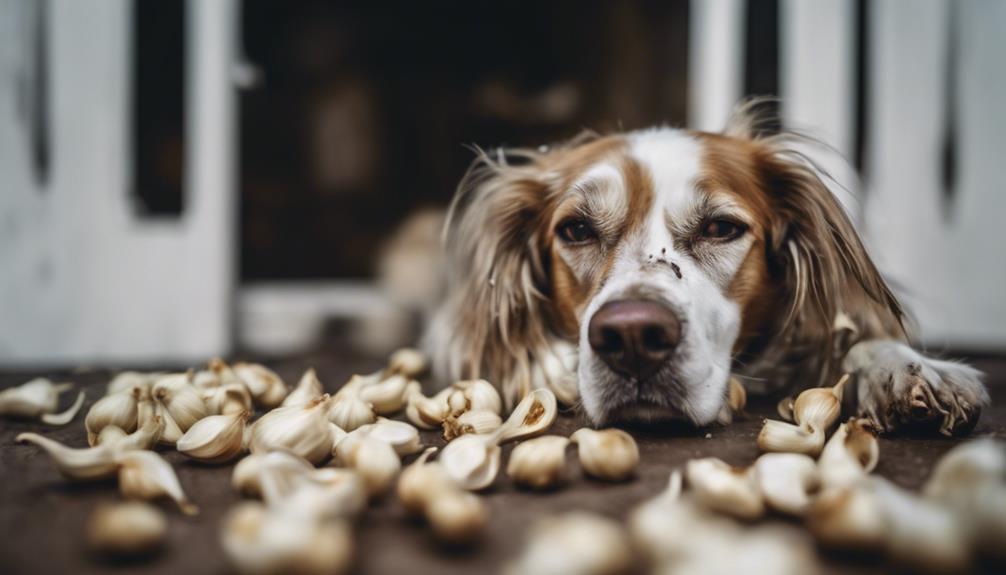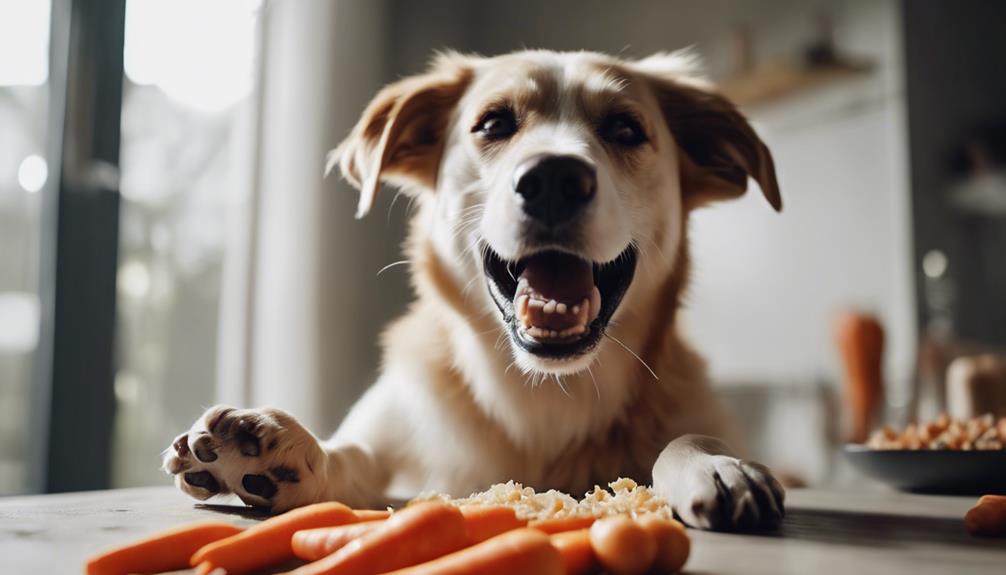Garlic, a common ingredient in many culinary dishes, harbors a hidden danger for our canine companions. The potential toxicity of garlic for dogs is often underestimated, yet its detrimental effects on their health can be severe.
As we explore the reasons behind why dogs should steer clear of this seemingly innocuous vegetable, the intricate interplay between garlic and a dog's physiology unveils a complex narrative that sheds light on the importance of informed decision-making when it comes to our furry friends' dietary choices.
Key Takeaways
- Garlic is toxic to dogs, belonging to the Allium species like onions and chives.
- Even small amounts of garlic can be dangerous due to its concentrated toxicity.
- Garlic bread poses a risk of toxicity and can lead to pancreatitis in dogs.
- Recognizing symptoms of garlic poisoning is crucial for prompt treatment to prevent anemia and organ damage.
Toxicity of Garlic for Dogs
Garlic, a member of the Allium species, poses a significant toxicity risk to dogs similar to onions, leeks, and chives. Even small amounts of garlic can be dangerous due to its concentrated toxicity. Dogs have a lower margin of safety for garlic compared to other toxic foods. Less than 0.1 ounce of garlic per pound of a dog's weight is considered toxic.
It is crucial to prevent dogs from accessing garlic to avoid poisoning incidents. The concentrated nature of garlic's toxic compounds makes it a serious threat to canine health. Therefore, responsible pet ownership involves keeping all forms of garlic, including dried forms like garlic powder and salt, out of reach of dogs to ensure their well-being.
Forms of Garlic to Avoid
When considering the safety of canine diets, it is essential to be mindful of specific forms of seasoning that can pose a risk to dogs' health. Dried forms like garlic powder and salt are more concentrated and dangerous. Extra caution is advised when using garlic powder or salt in dog's food. The concentrated nature of these seasonings makes them riskier than fresh garlic. It's crucial to avoid using garlic powder or salt in any dog treats or meals and keep all forms of garlic away from dogs.
| Forms of Garlic to Avoid | Risk Level |
|---|---|
| Garlic Powder | High |
| Garlic Salt | High |
| Fresh Garlic | Low |
| Cooked Garlic | Low |
| Raw Garlic | Low |
Risk of Garlic Bread

Considering the potential health risks associated with specific forms of garlic seasoning for dogs, it is imperative to address the notable danger posed by the consumption of garlic bread. Garlic bread presents a risk of toxicity to dogs due to the presence of garlic, which is harmful to them.
Additionally, the high-fat content in garlic bread can potentially lead to pancreatitis and obesity in dogs. Despite its enticing smell, garlic bread should be strictly avoided when it comes to feeding dogs.
It is essential for pet owners to prioritize the well-being of their dogs by refraining from offering garlic bread as a treat and opting for safer alternatives to prevent any adverse health effects associated with garlic consumption.
Symptoms of Garlic Poisoning
The manifestation of garlic poisoning in dogs includes a range of distinct symptoms that indicate potential toxicity. Garlic toxicity can lead to various forms of anemia in dogs, which can be life-threatening or result in long-term organ damage. Recognizing signs of garlic poisoning is essential for prompt treatment.
The symptoms of garlic poisoning may include:
- Diarrhea
- Vomiting
- Lethargy
- Pale gums
If your dog displays any of these symptoms and you suspect garlic ingestion, seek immediate veterinary assistance to prevent further complications. Early intervention is crucial in mitigating the effects of garlic toxicity on your beloved pet.
Treatment for Garlic Poisoning

Effectively managing garlic poisoning in dogs requires prompt and comprehensive veterinary intervention to safeguard their health and well-being. Upon suspecting garlic ingestion, contacting a veterinarian or the Pet Poison Helpline immediately is crucial. Inducing vomiting should only be done under professional guidance to prevent further complications. Treatment options for garlic poisoning may involve providing supportive care, administering IV fluids, or using activated charcoal to help absorb the toxins. In severe cases, a blood transfusion might be necessary to address the adverse effects of garlic toxicity. Preventative measures, such as keeping garlic out of reach, remain the best way to protect dogs from potential harm.
| Treatment Options | Description |
|---|---|
| Supportive Care | Monitoring vital signs and providing comfort to the dog during recovery. |
| IV Fluids | Administering fluids intravenously to help flush out toxins and maintain hydration. |
| Activated Charcoal | Aiding in toxin absorption by binding to the harmful substances in the gastrointestinal tract. |
| Blood Transfusion | Required in severe cases to address anemia or organ damage resulting from garlic poisoning. |
Importance of Prompt Action
Upon suspecting garlic ingestion in dogs, immediate veterinary intervention is imperative to mitigate potential harm and ensure their well-being. Quick action can make a significant difference in the outcome of garlic poisoning cases in dogs. Here are some reasons why prompt action is crucial:
- Rapid Elimination: Prompt treatment can help in eliminating the toxic effects of garlic from the dog's system.
- Prevention of Complications: Timely intervention can prevent the development of severe complications associated with garlic toxicity.
- Professional Guidance: Veterinary professionals can provide the necessary care and treatments tailored to the individual dog's needs.
- Monitoring and Support: Early veterinary intervention allows for close monitoring and support, enhancing the chances of a full recovery for the affected dog.
Long-Term Effects on Dogs

Long-term exposure to garlic in dogs may result in persistent health complications that necessitate ongoing veterinary monitoring and care. Continuous ingestion of garlic can lead to cumulative organ damage, particularly affecting the red blood cells and causing anemia.
Chronic exposure to garlic's toxic compounds can weaken the immune system, making dogs more susceptible to infections and illnesses. Prolonged consumption of garlic may also impact the digestive system, leading to gastrointestinal issues such as chronic inflammation and malabsorption of nutrients.
Additionally, long-term exposure to garlic can have detrimental effects on a dog's overall well-being, potentially reducing their quality of life and longevity. Therefore, it is crucial to prevent dogs from accessing garlic to safeguard their health in the long run.
Risks of Garlic Seasonings
Continued exposure to garlic seasonings poses a significant risk to dogs due to their concentrated toxicity, warranting vigilant measures to prevent inadvertent ingestion and subsequent health complications.
When it comes to garlic seasonings, it's crucial to consider the following:
- Concentrated Toxicity: Garlic seasonings are more potent than fresh garlic, increasing the risk of poisoning.
- Hidden Presence: Seasonings may be present in unexpected foods, so always check ingredients carefully.
- Accumulative Effect: Even small amounts of garlic seasoning over time can build up toxicity in a dog's system.
- Cross-Contamination: Ensure that utensils and surfaces used for garlic seasonings are kept separate from pet-related items to avoid accidental exposure.
Alternative Safe Treats

Consider exploring alternative safe treats for dogs as a healthier and non-toxic option to avoid potential risks associated with garlic consumption. When choosing treats for your furry friend, opt for safe and dog-friendly options that will keep them happy and healthy. Here are some alternative treats you can consider:
| Treat Option | Benefits |
|---|---|
| Carrot Sticks | Rich in vitamins and low in calories |
| Blueberries | Packed with antioxidants and delicious |
| Peanut Butter | High in protein and a favorite among dogs |
| Plain Popcorn | Low-calorie snack for occasional treats |
| Cooked Sweet Potato | Great source of fiber and nutrients |
These alternative treats provide a variety of flavors and nutrients without the risks associated with garlic consumption.
Safeguarding Your Dog's Health
To ensure the well-being of your canine companion, prioritizing preventive care and fostering a safe environment are paramount in safeguarding your dog's health. Here are some key strategies to protect your dog's health:
- Regular veterinary check-ups and vaccinations are essential for early disease detection and prevention.
- Providing a balanced diet tailored to your dog's nutritional needs supports overall health and longevity.
- Regular exercise helps maintain a healthy weight, promotes mental well-being, and strengthens the bond between you and your dog.
- Keeping your home environment safe by removing potential hazards and ensuring your dog's access to fresh water and shelter enhances their quality of life.
Conclusion
In conclusion, the ingestion of garlic poses a significant threat to the health and well-being of dogs due to its toxic properties. Dog owners must be vigilant in avoiding all forms of garlic, including dried forms and seasonings, to prevent garlic poisoning.
Understanding the symptoms and risks associated with garlic consumption is crucial in safeguarding the health of dogs.
By taking preventive measures and opting for alternative safe treats, dog owners can ensure the safety of their beloved pets.




